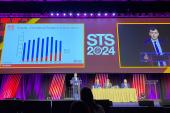TAVI, SAVR Rates Roughly Equal for Patients Younger Than 65 in New England
The findings corroborate a California analysis earlier this year, reinforcing the case for a randomized trial in young patients.

ATLANTA, GA—Another observational study has shown—this time in New England—that about half of patients with severe aortic stenosis under the age of 65 are receiving TAVI, contrary to current guidelines that preferentially recommend surgery.
The data, out of New Hampshire, Maine, and Vermont, demonstrate that 51.7% of these patients received TAVI in 2022, echoing what has been seen in California.
Given the lack of data directly comparing TAVI and SAVR in patients under age 65 with severe aortic stenosis, and the established durability of surgical valves, both US and European guidelines recommend the latter over the transcatheter approach for this age group.
“What this proves to me is that more TAVR is happening in patients younger than 65 and most of these patients are low risk,” Tanush Gupta, MD (University of Vermont Medical Center, Burlington), who will be presenting the findings as a poster at the upcoming American College of Cardiology 2024 Scientific Session, told TCTMD. “Practice has definitely moved beyond the evidence demonstrated by the low-risk trials and beyond what the guidelines recommend.”
He urged the cardiovascular community to “be prepared for the aortic valve reintervention that is going to come in these patients, we expect 10 years after the implant.” This will be particularly important if TAVI valves prove to be less durable than surgical predecessors. Innovative designs that improve options for redo TAVI as well as defining best practices for TAVI explant will be key, Gupta said.
To TCTMD, Jad Malas, MD (Cedars-Sinai Medical Center, Los Angeles, CA), who presented the California data at the Society of Thoracic Surgeons (STS) meeting in February, said the latest study “further corroborates that these trends are happening across the country. . . . A lot of people in the crowd would probably think this is just something that's happening in California, but now you're showing it's happening in New Hampshire, Vermont, Maine. It's probably happening across the country, it's just a matter of actually looking at the data.”
Raising eyebrows when presented at the STS meeting, the California analysis, which was also observational and based on propensity matching, additionally showed a 2.5-fold increased risk of death at 5 years with TAVI over surgery. These new results, on top of the prior analysis, reemphasizes the need for a randomized clinical trial looking at long-term outcomes for these patients, Malas continued. “Practice is changing and it's going against current guidelines, and we don't have any data to really inform our patients on what they should expect long-term.”
TAVI, SAVR Even in Younger Patients
For the study, which will be simultaneously published as a research letter in JSCAI, Gupta and colleagues included 6,728 patients with severe aortic stenosis (40.2% women) from the Northern New England Cardiovascular Disease Group Consortium who underwent isolated TAVI (n = 5,094) or SAVR (n = 1,634) at one of four institutions in Maine, Vermont, and New Hampshire between 2016 and 2022.
Patients were stratified by age into three categories: < 65 (11.2%), 65-80 (47.4%), and > 80 years (41.4%). TAVI dominated the oldest age group, growing from 86.1% to 97.8% over the course of the study. Similarly, among those aged 65-80, those choosing TAVI doubled from 42.1% to 80.6%.
Practice has definitely moved beyond the evidence demonstrated by the low-risk trials and beyond what the guidelines recommend. Tanush Gupta
But it was the youngest cohort who saw the rate of TAVI grow drastically—272% over the study period—to the point that the percutaneous option comprised 51.7% of all procedures in this group in 2022. Notably, within this cohort, patients undergoing TAVI tended to be slightly older than those receiving SAVR (60.7 vs 58.1 years) and to have a higher STS-PROM score (3.5% vs 1.5%; P < 0.001 for both). Two-thirds (67.4%) of patients who underwent TAVI had an STS-PROM score of less than 4%, whereas 94.6% of patients who had SAVR scored similarly.
Also, bicuspid disease was less likely (17.0% vs 44.2%) and prior CABG more common (17.0% vs 0.8%) among young TAVI compared with SAVR patients (P < 0.001 for both). On multivariate analysis, prior CABG (OR 33.4), chronic kidney disease (OR 3.96), and congestive heart failure (OR 2.24) were independent predictors of TAVI in patients younger than 65.
There was no difference observed in 30-day mortality between those aged less than 65 years who underwent TAVI or surgery (0.9% vs 0.8%).
For Gupta, the results, while concerning, are likely driven by patient preference for a less invasive procedure. Part of his consultation now for patients that are asking for TAVI includes an assessment as to whether they would be a good candidate for a TAV-in-TAV down the line. Even if the answer is no, he said, “a lot of the time, patients say ‘Technology has moved so much. Who knows what's going to be there 10-20 years down the line?’ I tell them, yes there is going to be progress, but the inherent problem will remain the same.”
Even so, he added, “you still have to offer them treatment.”
Future research should focus on the detailed risk profile of these patients and how they were classified by the heart team, said Gupta. “Did the heart team call these patients low risk? And if they were high risk, for what reasons were they called high risk or intermediate risk? A deep dive into the heart team decision to offer a TAVR in these patients is going to be informative and it's going to give us more of an insight into the nuances of these temporal trends.”
[Patients with a low STS-PROM score] really should, from a cardiac surgical perspective, be a slam-dunk AVR with great long-term outcomes. Jad Malas
Malas agreed. For patients with a low STS-PROM score, “what were those discussions like with providers?” he asked. “Why was the ultimate decision made to give them a TAVR rather than a SAVR? Because those are patients that really should, from a cardiac surgical perspective, be a slam-dunk AVR with great long-term outcomes.”
He envisions a nationwide provider and patient survey to help answer some of these questions. Another potential avenue to explore would be randomizing patients with equipoise to undergo either TAVI or SAVR and following them long-term, Malas said. “Because then we'll actually be able to educate patients appropriately.”
However, he continued, the question persists: “At what point do we give up on doing the trial because the community has spoken, and this is just how practice is being performed?”
Yael L. Maxwell is Senior Medical Journalist for TCTMD and Section Editor of TCTMD's Fellows Forum. She served as the inaugural…
Read Full BioSources
Gupta T, DeVries JT, Gilani F, et al. Temporal trends in transcatheter aortic valve replacement for severe aortic stenosis: from the Northern New England Cardiovascular Disease Group. JSCAI. 2024;Epub ahead of print.
Disclosures
- Gupta and Malas report no relevant conflicts of interest.





Comments